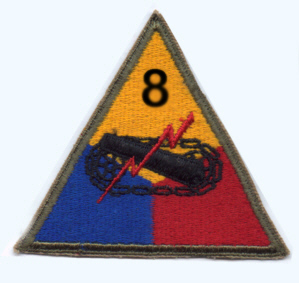Okey E. Taylor - Co. C, 58th A.I.B
8th US Armoured Division
We sailed for Europe on Election Day, Nov. 7, 1944 on the British troopship HMT Samaria. The ship was a British troop transport.

The patch of the 8th Armoured Division.
Final preparations for shipping out to France were made during the last week of December. It took quite some time to transport the entire division to Southampton and load the ships to go to France. When we landed at Le Harve, France and it took us several days to get our equipment organized and ready to leave. Our first assembly area after leaving Le Harve was in Rheims. We arrived there around the 10th of January where we bivouacked on the outskirts of town in a large open field. It had started to snow sometime during our trip and everything was snow covered. I am sure it would have looked beautiful if you had been inside to enjoy it but it was colder than hell outside.
We only stayed overnight at Rheims and then left for Pont-a-Mousson. It is a town about 100 miles southeast of Rheims. The Germans had made a drive toward Strasbourg and they were expected to continue towards Metz. This was the area where Gen. Patton had pulled out the troops used to help relieve Bastogne. The Eighth was ordered to move in that direction to counter this attack. Fortunately, the drive was halted before we were committed.

The cold was absolutely fierce during this period. We had to sit in the back of the half-tracks most of the time with our feet on the sheet metal plates of the floor. The boots did little if anything to keep our feet warm and some of the men got their feet severely frost bitten resulting in several cases of trench foot. The half-tracks were not heated and were open at the top so it was very hard to keep warm. The snow could drop in on our heads too. The half-tracks had canvas covers but I don't think I ever saw on of them put on except in the motor pools in the States.
When we stopped for a break we would light a quick fire to help warm us up. If we couldn't get enough wood for a fire we would take a number ten can and fill it up about a third of the way with sand and then add gasoline. We punched a few holes just above the sand line for air and when we lit it, we had a right reasonable fire. It was easy to extinguish when we had to mount up - piss on the fires and mount up, as we said - but you had to be careful when you lit it.
During the long march across France, we learned how to heat our rations in the engine compartment of the half-track. We couldn't always get served hot meals during marches because there was no way to prepare or serve them. Someone had made a mesh basket out of metal, which we hung in the engine compartment. We would punch a small hole in our ration cans and put them in the basket. They were nice and hot by time to eat. The only problem was if the hole was too small or if someone forgot to put one in his can. One of the cans blew up one time and the half-track driver was not happy with the effort it took to clean the mess out of the engine compartment.
I would have to give our mess personnel top honors for the way they performed during our long, cold marches. Every time we would stop someplace they would show up in a jeep or truck with a large 30-gallon pot of coffee, soup or hot chocolate, which they could serve quickly in our mess, cups. They usually had a lot of sandwiches too and we really appreciated this especially when the temperature was near zero and we couldn't heat our rations because when we were moving there wasn't time enough between stops. When we were moving at night, I have seen them show up at all hours with hot coffee and sandwiches. Sometimes we were asleep but it was worth waking up for.
Read his full wartime bio here..
© All rights reserved
Contact






